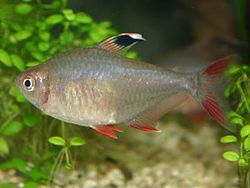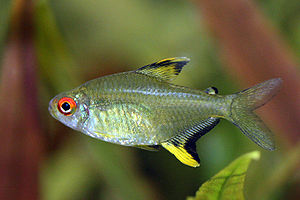- Hyphessobrycon
-
Hyphessobrycon 
Ornate tetra (H. bentosi) Scientific classification Kingdom: Animalia Phylum: Chordata Class: Actinopterygii Order: Characiformes Family: Characidae Genus: Hyphessobrycon
Durbin, 1908Species Around 100, see list
Synonyms - Megalamphodus
Eigenmann, 1915
Hyphessobrycon is a genus of freshwater fish in the characin family (family Characidae) of order Characiformes. The Hyphessobrycon species are among the fishes known as tetras. All species of this genus are native to the Neotropic ecozone in South America.
Contents
Taxonomy
This large genus of characins includes over 100 species.[1] The systematics of Hyphessobrycon is still largely unresolved.[2] Six groups within this genus have been recognized based on color patterns alone.[1] With no phylogenetic analysis of this genus, species are placed into this genus as anatomically defined by Carl H. Eigenmann in 1917.[3] By this definition, Hyphessobrycon is identified by the presence of an adipose fin, incomplete lateral line, two tooth series in the premaxilla, with the teeth of the external series continuous in a single series, teeth not strictly conical, preventral scales arranged in more than one row, and lack of scales in the caudal fin.[3] The characteristic of extension of scales onto the caudal fin that differentiates this genus from Hemigrammus is not satisfactory as it occurs in intermediate conditions.[3]
This genus is not monophyletic.[3] A monophyletic group within Hyphessobrycon has been hypothesized, termed the rosy tetra clade; this group is based upon coloration pattern and the shape of dorsal and anal fins of males.[1] Recognition of monophyletic groups among Hyphessobrycon species is complicated by the difficulty in finding characters useful for hypothesis of relationships among the species.[1] Traditional characters used to identify Hyphessobrycon are phylogenetically unreliable.[1]
The type species is H. compressus, the Mayan tetra.[4] The generic name, Hyphessobrycon, is of slightly uncertain origin. The second part derives from the Greek βρύκω (to bite); the first, derives from an ostensible Greek hyphesson, which may be an error for υπελάσσων (slightly smaller).[4]
Distribution
The genus is distributed from southern Mexico to Río de La Plata in Argentina, achieving its highest diversity in Cisandean northern South America.[2]
Appearance and anatomy
All small fishes, the Hyphessobrycon tetras reach maximum overall lengths of about 2–7 cm (0.75–2.75 in). There is great anatomical diversity in this genus.[3] They are generally of typical characin shape, but vary greatly in coloration and body form, many species having distinctive black, red, or yellow markings on their bodies or fins.
Ecology
The Hyphessobrycon species are generally omnivorous, feeding predominantly on small crustaceans, insects, annelid worms, and zooplankton. When spawning, they scatter their eggs and guard neither eggs nor young.
Relationship to humans
None of the roughly one hundred fishes in the genus appears on the IUCN Red List of threatened species. Many Hyphessobrycon species are popular aquarium fish.
Species
Species list according to the Integrated Taxonomic Information System, with notes for newer species.[5] New species continue to be described.
- H. agulha
- H. albolineatum
- H. amandae – Ember tetra
- H. amapaensis
- H. anisitsi
- H. arianae
- H. axelrodi – Calypso tetra
- H. balbus
- H. bentosi – Ornate tetra
- H. bifasciatus – Yellow tetra
- H. borealis
- H. boulengeri
- H. cachimbensis
- H. catableptus
- H. coelestinus
- H. columbianus
- H. compressus – Mayan tetra
- H. condotensis
- H. copelandi
- H. cyanotaenia – Lapis tetra
- H. diancistrus
- H. duragenys
- H. ecuadorensis
- H. ecuadoriensis
- H. eilyos[2]
- H. elachys
- H. eos – Dawn tetra
- H. epicharis
- H. eques – Serpae tetra
- H. erythrostigma – Bleeding-heart tetra
- H. fernandezi
- H. flammeus – Flame tetra
- H. frankei
- H. georgettae
- H. gracilior
- H. griemi – Goldspotted tetra
- H. guarani
- H. hamatus[1]
- H. haraldschultzi
- H. hasemani
- H. heliacus Moreira, Landim & Costa, 2002
- H. herbertaxelrodi – Black neon tetra
- H. heteresthes
- H. heterorhabdus – Flag tetra
- H. hexastichos[6]
- H. hildae
- H. igneus
- H. iheringi
- H. inconstans
- H. isiri
- H. itaparicensis
- H. khardinae[7]
- H. langeanii[2]
- H. latus
- H. loretoensis – Loreto tetra
- H. loweae
- H. luetkenii
- H. maculicauda
- H. megalopterus – Black phantom tetra
- H. melanopleurus
- H. melanostichos[8]
- H. melasemion
- H. melazonatus
- H. meridionalis
- H. metae
- H. micropterus
- H. milleri
- H. minimus
- H. minor
- H. moniliger
- H. mutabilis
- H. negodagua
- H. nigricinctus – Morado tetra
- H. notidanos[8]
- H. oritoensis[9]
- H. otrynus
- H. panamensis
- H. parvellus
- H. peruvianus – Peruvian tetra
- H. piabinhas
- H. poecilioides
- H. procerus
- H. proteus
- H. pulchripinnis – Lemon tetra
- H. pyrrhonotus
- H. pytai
- H. reticulatus
- H. robustulus
- H. rosaceus – Rosy tetra
- H. roseus – Yellow phantom tetra
- H. rutiliflavidus[10]
- H. saizi
- H. santae
- H. savagei
- H. scutulatus[3]
- H. schauenseei
- H. scholzei – Blackline tetra
- H. simulatus
- H. socolofi – Spotfin tetra
- H. sovichthys
- H. stegemanni – Savanna tetra
- H. stramineus
- H. sweglesi – Red phantom tetra
- H. takasei – Coffee-bean tetra
- H. taurocephalus
- H. tenuis
- H. togoi
- H. tortuguerae
- H. tropis
- H. tukunai
- H. uruguayensis
- H. vilmae
- H. wajat
- H. weitzmanorum[2]
- H. werneri
References
- ^ a b c d e f Bertaco, Vinicius A.; Malabarba, Luiz R. Malabarba (2005). "A new species of Hyphessobrycon (Teleostei: Characidae) from the upper rio Tocantins drainage, with bony hooks on fins" (PDF). Neotropical Ichthyology 3 (1): 83–88. doi:10.1590/S1679-62252005000100004. http://www.ufrgs.br/ni/vol3num1/Bertaco%20&%20Malabarba.pdf.
- ^ a b c d e Lima, Flávio C. T.; Moreira, Cristiano R. (2003). "Three new species of Hyphessobrycon (Characiformes: Characidae) from the upper rio Araguaia basin in Brazil" (PDF). Neotropical Ichthyology 1 (1): 21–33. doi:10.1590/S1679-62252003000100003. http://www.ufrgs.br/ni/vol1num1/artigo03.pdf.
- ^ a b c d e f de Lucena, Carlos Alberto Santos (2003). "New characid fish, Hyphessobrycon scutulatus, from the rio Teles Pires drainage, upper rio Tapajós system (Ostariophysi: Characiformes: Characidae)" (PDF). Neotropical Ichthyology 1 (2): 93–96. http://www.ufrgs.br/ni/vol1num2/1(2)artigo03.pdf.
- ^ a b Froese, Rainer, and Daniel Pauly, eds. (2007). Species of Hyphessobrycon in FishBase. May 2007 version.
- ^ "Hyphessobrycon". Integrated Taxonomic Information System. http://www.itis.gov/servlet/SingleRpt/SingleRpt?search_topic=TSN&search_value=162860. Retrieved May 31, 2007.
- ^ Bertaco, Vinicius A.; Carvalho, Tiago P. (2005). "A new characid fish, Hyphessobrycon hexastichos (Characiformes: Characidae) from Chapada dos Parecis, Mato Grosso, Brazil" (PDF). Neotropical Ichthyology 3 (3): 439–443. doi:10.1590/S1679-62252005000300013. http://www.ufrgs.br/ni/vol3num3/artigo13.pdf.
- ^ Zarske, Axel (2008). "Hyphessobrycon khardinae sp. n. – ein neuer Blutsalmler aus Brasilien (Teleostei: Characiformes: Characidae)". Vertebrate Zoology 58: 5–13.
- ^ a b Carvalho, Tiago Pinto; Bertaco, Vinicius Araújo (2006). "Two new species of Hyphessobrycon (Teleostei: Characidae) from upper rio Tapajós basin on Chapada dos Parecis, Central Brazil" ([dead link] – Scholar search). Neotropical Ichthyology 4 (3): 301–308. doi:10.1590/S1679-62252006000300001. http://www.ufrgs.br/ni/vol4num3/NIv4n3p301-308.pdf.
- ^ García-Alzate, Román-Valencia & Taphorn (2008). "Hyphessobrycon oritoensis (Characiformes: Characidae), a new species from the Putumayo River drainage, Colombian Amazon". Zootaxa 1813: 42–50. http://www.mapress.com/zootaxa/2008/f/z01813p050f.pdf.
- ^ Carvalho; et al. (2008). "Hyphessobrycon rutiliflavidus n. sp., a new characid fish from the upper rio Paraguai, State of Mato Grosso, Brazil (Characiformes: Characidae)" (PDF). Zootaxa 1674: 39–49. http://mapress.com/zootaxa/2008/f/z01674p049f.pdf. Retrieved 2009-06-23.
Categories:- Tetras
- Fish of South America
- Megalamphodus
Wikimedia Foundation. 2010.

